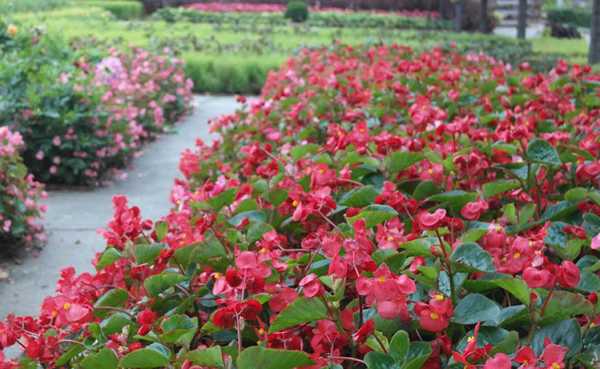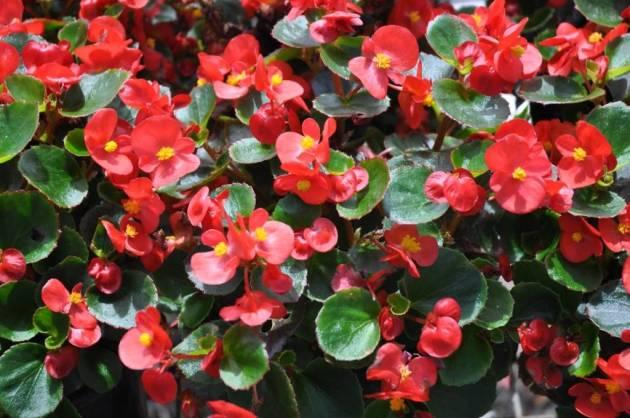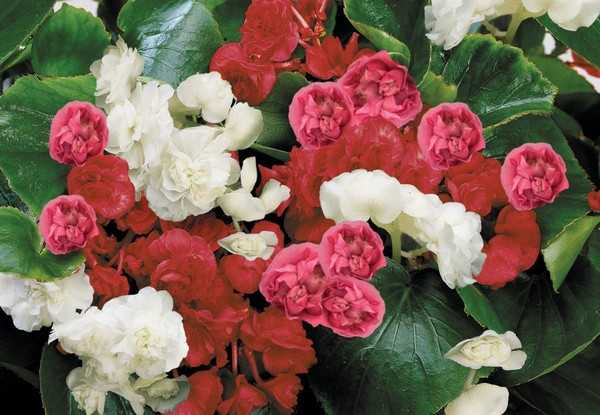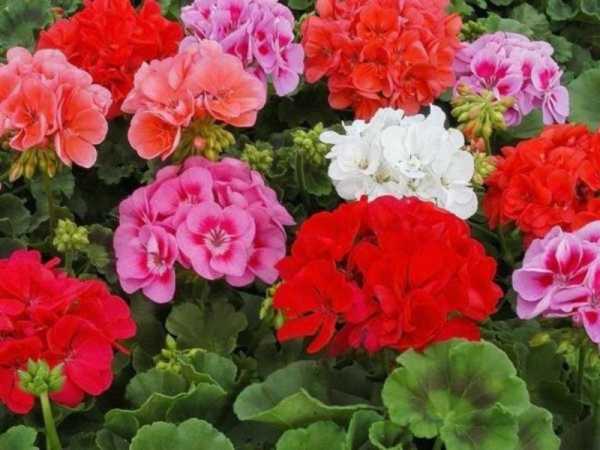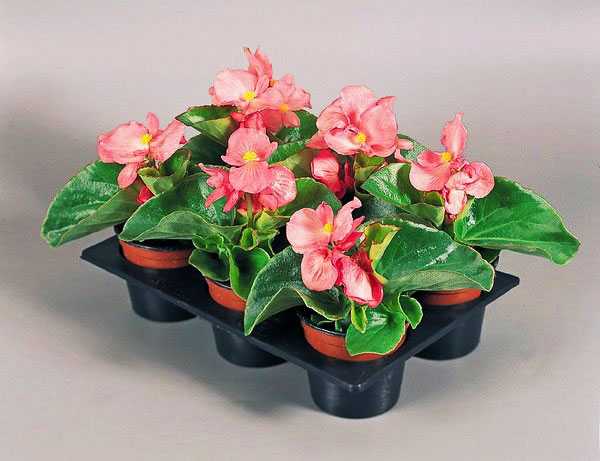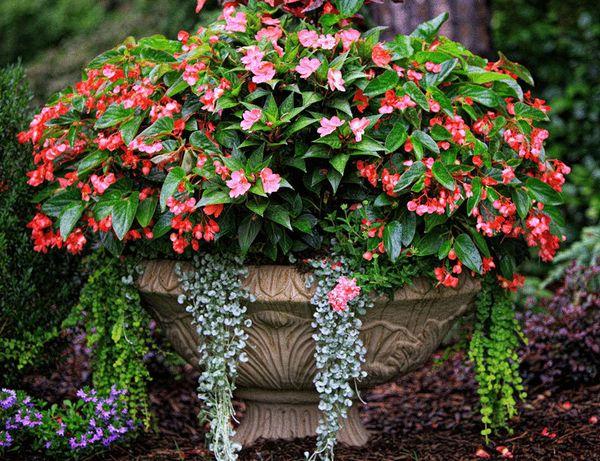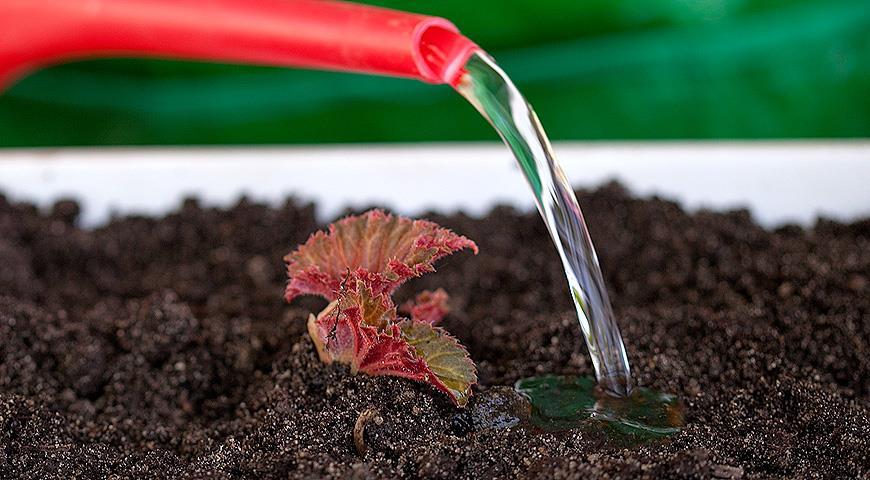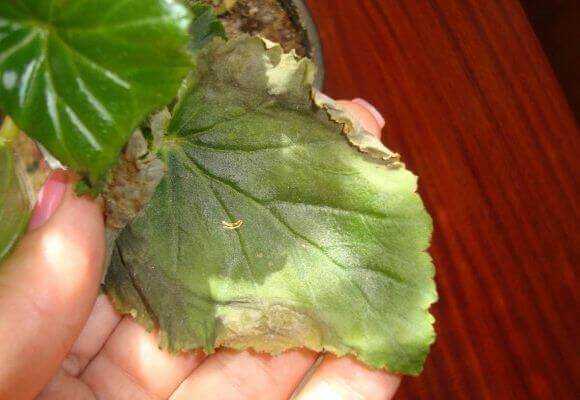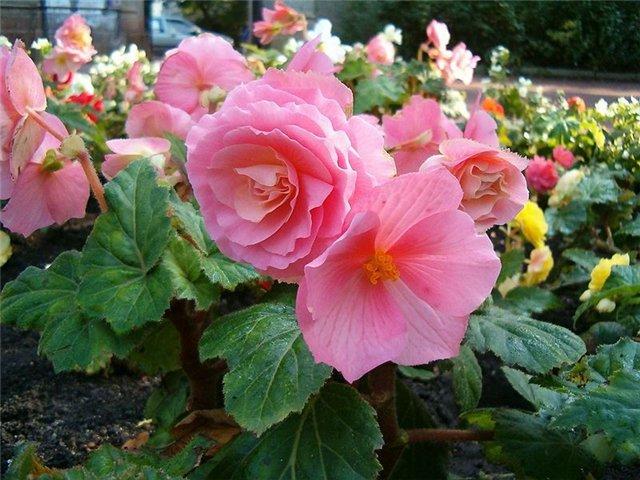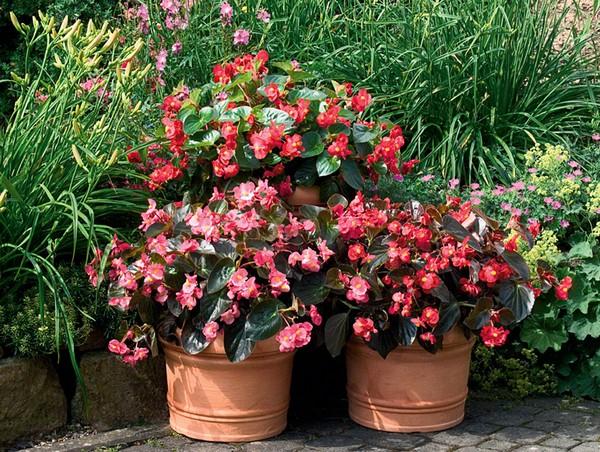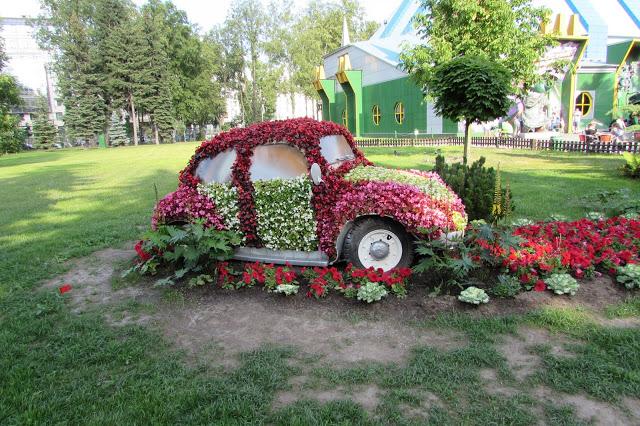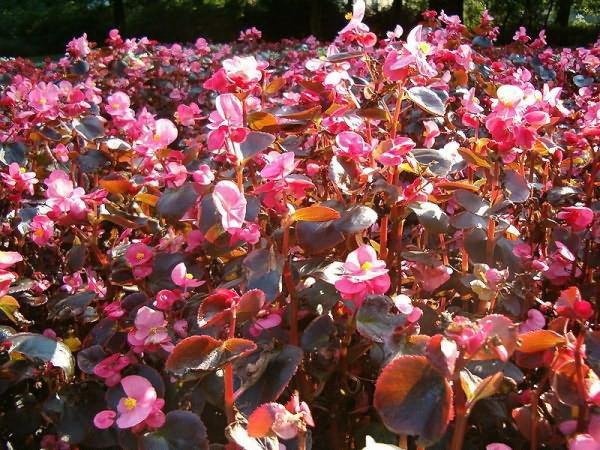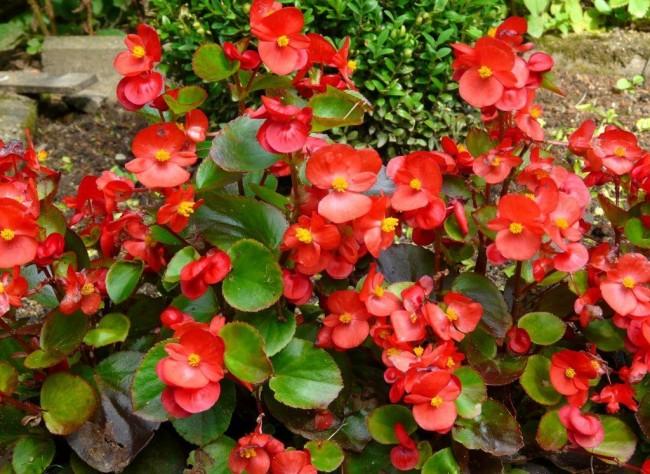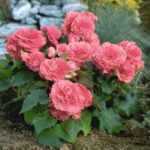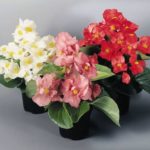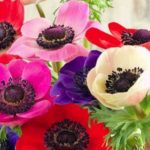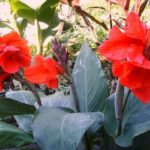In their natural habitat, everflowering begonias are found in the tropical forests of South America. Thanks to many years of work by scientists and breeders, hybrid plant varieties have been created that are grown with great success in any climatic zone. Begonia is an unpretentious flower. Therefore, it grows successfully both in the open ground of personal plots and at home.
- Varieties and varieties of crops
- Tall
- Medium height
- Dwarf
- Features of reproduction
- Seeds
- Cuttings
- Caring for evergreen begonia at home
- Selection of tubers for planting
- Location and lighting
- Temperature
- Spray frequency
- Watering
- Feeding and pruning
- Diseases and pests: methods of control and prevention
- Begonia in landscape design
- How to plant and grow a plant in the garden
- Preparing the tubers and planting hole
- Timing and technology of planting in open ground
- We organize proper care
- Irrigation and soil moistening
- Loosening the soil
- Transplantation and formation
- Preparing the flower for winter
- We protect against parasites and diseases
- What problems might you encounter?
- When growing a flower at home
- In an open area
Varieties and varieties of crops
Varieties of ever-flowering begonia differ in plant height, leaf color, size and color of inflorescences.
Tall
The largest representatives of the culture are tall varieties of begonia from 25 to 45 cm:
- Terry begonia variety Elatior is distinguished by tall bushes and lush, large flowers.
- The Volumia variety is resistant to hot climates and drought. A plant with bright green foliage and large flowers of different shades.
- The Lotto variety is one of the tallest representatives of the crop. Its bushes grow up to 40-45 cm. The leaves are waxy and green. The inflorescences are large, the opened flower is 4-5 cm in diameter.
- The Stara variety is densely covered with dark green leaves. Inflorescences are small but frequent. During the flowering period, the plant is completely covered with medium-sized flowers.
- Begonia "Pati" grows up to 30 cm. The leaves are waxy, green or brown. Inflorescences are large and frequent. This type of plant comes with red, pink or white flowers.
Medium height
Medium-sized plants from 20 to 25 cm look great in garden beds and are used in complex floral compositions:
- Begonia Ambassador is unpretentious to climatic conditions. The leaves are waxy, green with reddish or white edges.Large range of colors of flowering plants.
- Variety Vision with dark green leaves and large flowers of various shades.
- Senator is an unusual variety. Against the background of bronze foliage, bright shades of flowers look especially elegant.
- Bada Bing has green leaves with a thin white edge. The hybrid is available in several shades.
Dwarf
The most compact representatives of the culture are dwarf begonia species. Plant sizes range from 5 to 20 cm, great for flower beds and garden arrangements:
- Variety Cocktail. Due to its compact size, red foliage with a brown tint and abundant flowering, the plant is in demand by gardeners and flower growers.
- Ray - resistant to weather conditions and temperature changes. Miniature bushes are covered with green foliage and white flowers with a thin pink border.
- The Queen variety is distinguished by double flowers of different shades.
- Begonia Eureka. The leaves are green with a bronze tint, the flowers are large.
Important! When planting flowers in open ground, we must not forget that the plant is of tropical origin, so it needs special conditions for growth and flowering.
Features of reproduction
To increase the number of beautiful flowers, they are propagated. There are several ways to increase the number of flowering begonias in your garden or home.
Seeds
Reproduction of a hybrid plant by seeds requires certain knowledge:
- Begonia seed material is similar to small grains of sand, so it is difficult to work with. When sowing, the seeds are mixed with sand, this makes it possible to distribute them evenly in the soil.
- The prepared soil is watered before planting the seeds; after planting, watering is not carried out.
- Boxes or pots with planted flowers are covered with film or glass.
- After the first 2-3 leaves appear, the seedlings are planted in different pots.
- For seed germination, a comfortable temperature range from +22 to +24 degrees is created.
- If the soil dries out, it is sprayed with a fine spray bottle.
Important! Hybrid varieties of flowers when propagated by seed may lose the characteristics of the mother plant.
Cuttings
By propagating the crop by cuttings, strong, viable seedlings are obtained.
At the beginning of spring, the upper branches, also known as cuttings, are cut off from adult flowers. Next, the cuttings are placed in water and covered with film. After the first roots appear, the plant is planted in light soil, and with the onset of warm days, it is sent to open ground.
Caring for evergreen begonia at home
Begonia evergreen is often grown at home. This indoor plant is suitable for decorating the interior of a house or apartment, winter garden, balcony or loggia.
Selection of tubers for planting
The most beautiful flowers grow from tubers. When purchasing planting material, the following factors are taken into account:
- The tubers are not overdried.
- Strong seed with a diameter of 5 to 6 cm is selected.
- Each tuber has a small sprout.
- If there are no buds on the tuber, then it must be kept in the sun for several days.
- Tubers without obvious damage or flaws. If incomprehensible symptoms are detected, the tubers are treated with a manganese solution.
- When planting, large tubers are divided into several parts. Each part must have an active bud.
Planted tubers are germinated in a warm, bright room.
Location and lighting
Begonia everblooming is an unpretentious crop and takes root in any soil.But for proper growth and development of the flower, it is still recommended to purchase a special soil mixture for growing begonias.
Although the plant has tropical roots, it does not respond well to direct sunlight. But for active flowering it needs good lighting. Also, flowers do not like to change their place of residence. Having decided to grow this crop at home, you need to clearly determine the place where it will be permanently located. Windows facing west or east are suitable for the growth and flowering of begonias.
Temperature
When growing a plant at home, the gardener expects begonia to bloom all year round. And so that the flowering period does not end, compliance with the temperature regime is necessary. The plant grows and develops comfortably at temperatures from +18 to +24 degrees. Air humidity
Flower growth requires high air humidity. And the required percentage of humidity is maintained by installing additional sources of moisture or purchasing an air humidifier.
Spray frequency
Moisture is needed not only by the roots, but also by the leaves of flowers. But with frequent spraying, spots appear on the leaves, which negatively affects their decorative properties. Therefore, they spray the room where the plant is located.
Watering
Insufficient moisture also affects flowering. Water the flower as needed, as soon as the top layer of soil dries out. If, after watering, water accumulates in the trays, it is immediately removed to prevent rotting of the roots. On hot and dry days, the flower needs to be watered additionally.
Important! Water the flowers with settled and warm water.
Feeding and pruning
A constantly flowering plant requires additional feeding.At the beginning of the growing season, flowers are fed with fertilizers, which include phosphorus and potassium. Next, use special fertilizers for flowering plants. To make the plant look lush and beautiful, excess layers are cut off from it.
As soon as the flower begins to actively grow upward, the shoots are cut off and their growth is stopped using special clamps.
Diseases and pests: methods of control and prevention
Even at home, the flower is susceptible to pests and diseases. If a begonia gets powdery mildew, this is the first sign of improper watering. The plant is treated with fungicides. When the roots and stems rot, the damaged areas are removed, and the plant, having been pre-treated with special preparations, is transplanted into fresh soil. The flower is also susceptible to attack by aphids, spider mites and nematodes. In this case, begonia is treated with insecticides.
Important! Chemical treatment of plants is carried out outside residential premises.
Most diseases and pests are the result of improper care of this tropical beauty. Therefore, try not to violate the rules of watering and moisturizing, and then the plant will have no chance of getting sick.
Begonia in landscape design
Landscape designers love begonia for its decorative properties. Flowers are used for flower beds, decorating alpine slides, gazebos and garden paths. Small islands of blooming begonias on a green lawn will add bright colors to the garden plot and improve the mood of the owners.
How to plant and grow a plant in the garden
Ever-flowering begonia will quickly take root in the open ground of a personal plot, if no gross mistakes or violations were made during planting.
Preparing the tubers and planting hole
Tubers for planting are selected large, without visible damage. It is best to purchase planting materials from specialized nurseries or garden centers.
The tuber must have a bud. In the absence of an active bud, the tubers are laid out in sunlight and left for several days. As soon as a small sprout has appeared, the tuber can be planted in the ground. Before planting, begonia tubers are kept in a solution of manganese or fungicide for 30-40 minutes.
Begonia is not a picky flower, but the soil must be thoroughly loosened before planting. If the soil has a high acid content, then add lime. Holes for planting flowers are dug based on the size of the plant. If the begonia is tall, then the distance between the holes is at least 30 cm, for medium bushes it is 20 cm, and dwarf flowers are planted at a distance of 10-15 cm.
Timing and technology of planting in open ground
Planting work begins depending on the climatic conditions of the region. You can plant tubers in open ground after the end of night frosts. Seedlings are planted in late spring or early summer.
The place for planting is shaded, but not shady. The plant needs a lot of sunlight, but begonia does not tolerate direct sunlight.
We organize proper care
Ever-flowering begonia is a complex hybrid variety, bred by crossing many species of this crop. But at the genetic level, the flower belongs to a tropical species, so it should be carefully cared for.
Irrigation and soil moistening
Begonia everblooming is a moisture-loving flower.Therefore, the irrigation regime must be observed. Flowers are watered in the morning, once every 2-3 days. Warm, settled water is poured under the plant itself, avoiding contact with the leaves. On hot and hot days, begonia requires additional moisture.
Loosening the soil
To allow oxygen to enter the root system, the soil is loosened if necessary. Typically, such work is carried out in conjunction with watering and fertilizing the plant.
Important! The roots of the flower are close to the soil surface, so loosening and removing weeds should be done carefully.
Transplantation and formation
To get a lush plant that will decorate your garden plot or garden, it should be pruned. As soon as the begonia grows to 15-20 cm, the upper branches of the flower are pinched, then the lateral branches actively develop and the begonia takes on a beautiful shape.
The flower does not require frequent transplants. Typically, young seedlings are transplanted into open ground in the spring, and back into pots or boxes in the fall.
Preparing the flower for winter
Begonia requires special preparation for wintering. Plants grown at home are simply transferred to houses and apartments for the winter, where they continue to develop and bloom. But flowers planted in open ground are unlikely to survive cold winters. Therefore, begonia tubers are dug up after the first frost and sent to a cool place for the winter, having first buried them with peat and moistened them. The plant can also be preserved by simply replanting it in a pot in the fall and putting it in a warm living room.
We protect against parasites and diseases
With proper care, evergreen begonia is not susceptible to various diseases and pests.Therefore, for prevention, it is enough to fully care for the plant, and the begonia will grow healthy and strong.
The main condition for care is proper and timely watering of the plant. It is because of a lack or excess of moisture that the flower gets sick. But if the plant becomes sick or is attacked by pests, then standard measures are taken to prevent further infection of neighboring flowers.
What problems might you encounter?
When growing beautiful flowers, gardeners and flower growers sometimes encounter problems on the solution of which the health and decorative properties of begonia depend.
When growing a flower at home
Sometimes indoor begonia does not form buds and therefore does not bloom. Let’s find out why the plant doesn’t bloom:
- The flower pot is placed in direct sunlight.
- Not enough watering.
- The begonia was not fertilized.
- The size of the pot or box does not suit the flower.
- The plant is sick or attacked by pests.
Important! To return the plant to the flowering phase, you need to know exactly the reason for its absence, and only then begin work.
In an open area
In open ground, flowers are exposed to the external environment, which can have a negative impact on their development and decorative characteristics:
- Gray rot. Dark spots appear on the leaves of the flower, and later a gray coating.
- Low air humidity.
- Lack of lighting.
- Wrong neighbors. Begonia will not bloom if oak or willow grows nearby.
- Excess moisture.
- Pests and fungal diseases.
Ever-blooming begonia pleases with its bright, colorful flowers all summer, and with proper and timely care, the plant blooms in winter.


